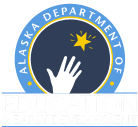- Cama-i, quyana tailuci!
- (Central Yup’ik)
- "Greetings, thank you for coming!"
Smokehouse project creates ample learning opportunities for Pilot Point students
Salmon is central to life in Pilot Point, Alaska. For teacher Robert Kirchner, that connection to salmon and the community created an opportunity to engage his students in a construction project that not only directly engaged his class in the building, but also tied into core academic areas.
Pilot Point is located at the mouth of the Ugashik River in Southwest Alaska. The Ugashik is one of the nine major river systems that feed into Bristol Bay – the largest wild sockeye salmon fishery in the world.
Pilot Point School’s enrollment is just over a dozen students. It was designated for comprehensive support in 2019. After that designation, the school held a series of community meetings to talk with families, students and the community about the needs and wants for the school. One theme that kept coming up was an interest in providing job-related learning experiences and training during school. As a result of the community meetings, the idea of building a smokehouse took hold as a way to provide a more interactive learning experience.
“A lot of people in the community are working in the trade industry, so it makes a lot of sense to be able to introduce students even at the middle school age to what’s out there and what it feels like to interact with that type of work,” Kirchner said. “We had already been fishing as a class. We go out and subsistence fish a couple of times in the Fall, and then we would process the fish together.”
With grant funding and the help of Mike Janecek, a former teacher and coach who is also a skilled craftsman, the secondary class worked to build the smokehouse in about a week.

“Our school is unique. We’re very small. Our students aren’t going from teacher to teacher on a bell schedule. We certainly have class periods, but there’s a lot more flexibility in our school because we don’t have as many moving part to align.” Kirchner said. “With a class our size, it’s just like a small work crew. We rotate students though having them try out different skills and tools.”
While the construction of the smokehouse was the main project, the benefits from the experience spilled over into other areas.
“Even with these more vocational on-the job, hands on type activities and learning experiences that we’ve tried to curate, we’re still trying to connect those to core academics because ultimately that’s something that we’re really trying to build up in our school culture. In some regards, these activities have an inherent engagement and benefit to them, but they also can then indirectly support other learning,” Kirchner said. “They can get kids more inspired and interested in just being in school, more excited, more confident, and I certainly try to show how the things that we’re learning in our other coursework, how they apply to these projects that we’re doing.”
In addition to building the smokehouse, Kirchner’s students produced a video using Adobe Spark (now known as Adobe Express) about the project using narrative writings compiled from the class and with the students’ voices recorded for narration.

“We did one project that was a construction project, but we also learned math and cultural history, and we learned writing skills and presentation skills and public speaking,” Kirchner said. “You need to have that balance – those highly engaging learning opportunities to then make everything else more engaging, to make students more excited to write about something because they just did it and they want to tell that story. That’s kind of the idea. It is to not just do something fun and interesting, but to do that and use to leverage even more academic growth.”
Though the smokehouse was completed last year, it was too late in the season to be used for that year’s fish. Kirchner said the class will use it this Fall. After that, Kirchner says the smokehouse may be donated to a family that needs it, it may be raffled off, or it may stay at the school.
“These projects are just so valuable. They’re super fun. Everybody’s smiling and into it, not moaning and groaning,” Kirchner said. “They’re challenging themselves, trying new things, but then it’s not just that. It makes everything work better in the school when you have those things. It’s not just limited to the experience itself, it affects everything in a good way.”

